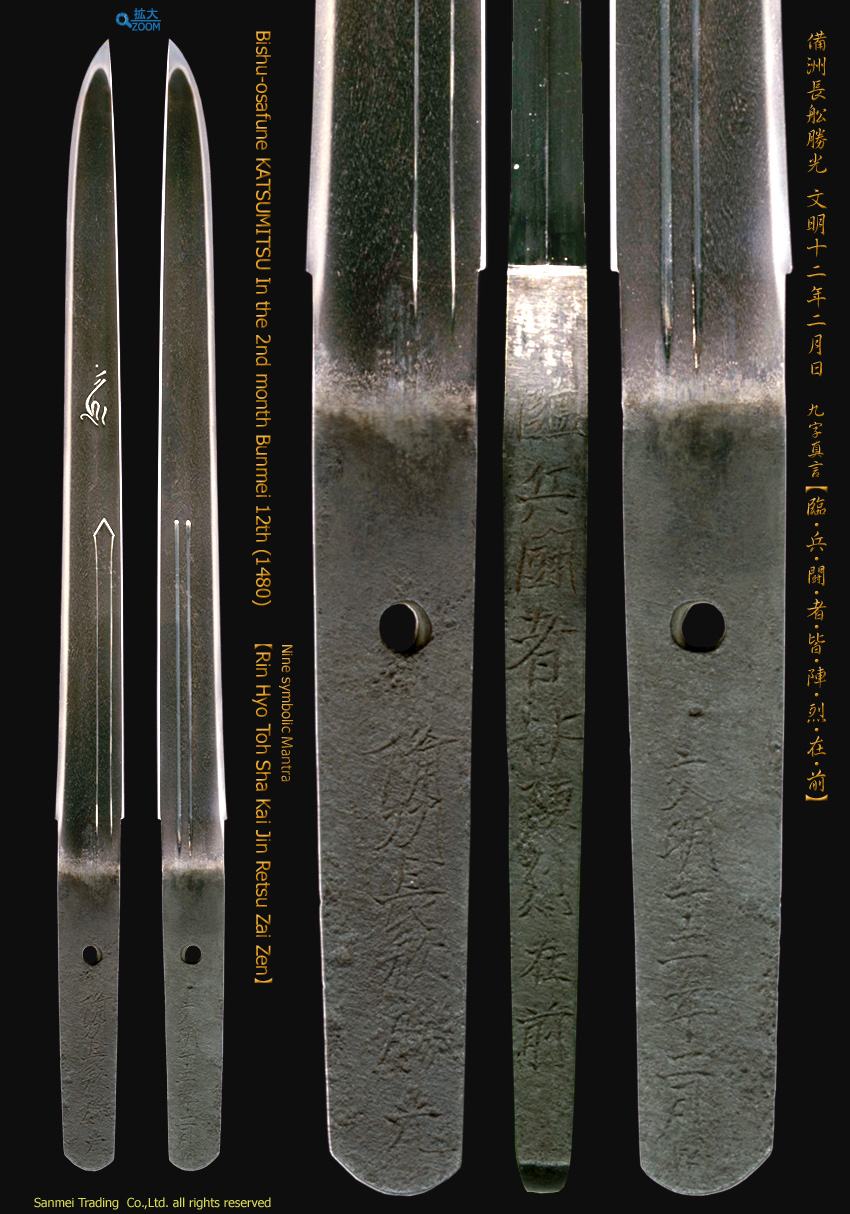(Nine Symbolic Mantra) Rin Hyo Toh Sha Kai Jin Retsu Zai Zen
with) Urumi-nuri blurred red lacquered scabbard AIKUCHI Tanto Koshirae
NBTHK Tokubetsu Hozon Token)
NBTHK Hozon Tosougu) for Kozuka
Rported in Osafune-cho-shi
Length of cutting edge 25.9cm A bit on inward curve Width of base 23.3mm Thickness of base 9.7mm
Horimono(carving) : Suken engraved carving is built on base and upper is chiselled with a Sanskrit character of Bonji. The other side is a pair of parallel grooves chopsticks "Goma-bashi" as the incarnation of guardian deity "Fudo-myouou"
Kitae(forging pattern) : Kitae is fine Itame hada in general with the indication of Mokume ware. The entire steel gives off Ji-nie of sparkling martensite particles glitter that comes from fine soaking steel and Bar-like whitish mist of Uturi has settled along upper Fukura area.
Hamon(tempering pattern) : Hamon is uniform bright Nie-deki with softly sparkling martensite particles of glitter to form Medium Suguha where shows delicate indication of short line of Nie Sunagashi.
Boshi (tip): Boshi forms Suguha, small circle then turns back in good manner.
Nakago(tang) : The tang is UBU original. well-contoured massive in Hiraji. One Mekugi-ana retaining hole. Sujikai slanting left filemarks and the back ridge of Nakago is flat where Nine Symbolic Mantra "Rin Hyo Toh Sha Kai Jin Retsu Zai Zen" is engraved. Shallow Ha-agari-Kurijiri of uneven U-shaped heel. Sophisticated dignified style of inscription Bishu Osafune KATSUMITSU 備州長船勝光 in front and the other side is engraved with the date of year In the 2nd month, Bunmei 12th (1480) 文明十二年二月日. The entire Nakago preserves an excellent taste of patina from 540 years or more.
The most famed brother swordsmiths KATSUMITSU 勝光 and MUNEMITSU 宗光 were extraordinarily entrusted by military governor turned Daimyo Akamatsu Masanori 赤松政則.
KATSUMITSU 勝光 with a secular name Ukyo'no'suke 右京亮 was born in Eikyo 7 (1435).His extant works with the date of year are recognized from Bunmei till Meiou era (1470-1500), considered as the Most Superior Made "Saijo-saku".
It is a matter of common knowledge that collaboration Wakizashi with younger brother MUNEMITSU at "Kusakabe, Bi'chu domain" on Bunmei 19th (1487), owed by Tokugawa IEYASU 徳川家康 is designated as an important cultural asset under NIKKO TOSHOGU MUSEUM.
The subject superior Yoroi-doshi Tanto by Ukyo'no'suke KATSUMITSU 右京亮勝光 in Bunmei 12 (1480) is unparalleled not only in unique construction but also engraving of the Nine Symbolic Mantra on the back ridge of Nakago to pray for success in battle and welfare of family.This unique tanto was surely designed and custom made by special demand from high class, gallant military commander in faith to show traditional, decent Yamashiro style looking up Rai works to add the extreme dulability for pratical stabbing through Yoroi armor.
Excellent condition with clear inscription of signature and delicate Yasrurime of filemarks holding great taste of patina bearing 540 years of history.
This Tanto is reported in the issue of Nihon Toko Jiten as well as carried in the Osafune Cho-shi.
with)Urumi-nuri blurred red lacquered scabbard AIKUCHI-style Tanto Koshirae
(click HERE for entire Koshirae / HERE for each fitting)
- Kozuka : Nawanoren rope curtain design, Shakudo Nanako-ji surface Takabori Gold Iroe, Gold back plate Ura-Hokin, attributed to a work of Kaga Goto(Hozon Tosougu)
- Menuki : Nawanoren rope curtain design, ShakudoYobori carving, attributed to a work of Kaga Goto
- Hilt : Red/black lacquered layskin Dashisame wrap
- Scabbard : Urumi-nuri blurred red lacquered scabbard
Recent excellent polish/Condition scale: excellent (using a scale of mint-excellent-very good-good-fair-poor)
reference :
Fujishiro Yoshio Nihon Toko Jiten/Koto-hen, Fujishiro Yoshio, 1975
Osafune-cho Osafune-cho-shi Token-hen Zuroku, 1998
Honma Kunzan/Ishii Masakuni, Nihonto Meikan, Yuzankaku, 1975
Honma Kunzan/Sato kan'ichi, Nihonto taikan, Otsuka Kogeisha, 1967




